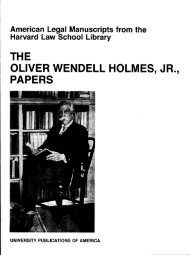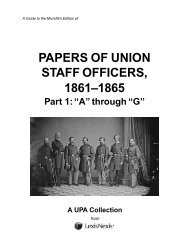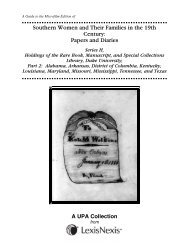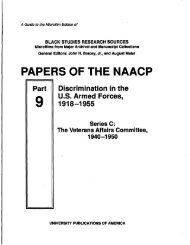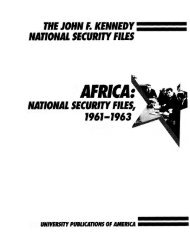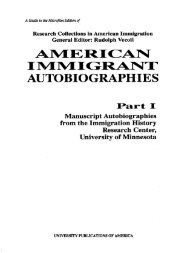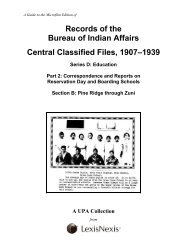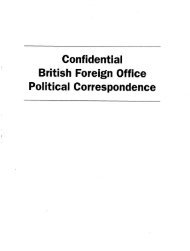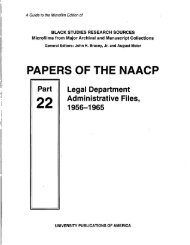Records of ante-bellum southern plantations - LexisNexis
Records of ante-bellum southern plantations - LexisNexis
Records of ante-bellum southern plantations - LexisNexis
You also want an ePaper? Increase the reach of your titles
YUMPU automatically turns print PDFs into web optimized ePapers that Google loves.
1887–1904 President <strong>of</strong> the University <strong>of</strong> Tennessee.<br />
1887–1890 Director <strong>of</strong> Tennessee Experiment Station.<br />
1893–1896 Assistant Secretary, U.S. Department <strong>of</strong> Agriculture.<br />
1897 Special agent, U.S. Department <strong>of</strong> Agriculture.<br />
1902–1904 Head <strong>of</strong> “Summer School <strong>of</strong> the South,” at Knoxville, Tennessee.<br />
1904–1920 President <strong>of</strong> the University <strong>of</strong> Cincinnati.<br />
1920–1945 Retired educator and scientist, active writer. Universal Education in the South<br />
(Chapel Hill: The University <strong>of</strong> North Carolina Press, 1936).<br />
Robert Lewis Dabney (1820–1898) was a Presbyterian clergyman and teacher and was<br />
associated with Hampden-Sydney College and with the Union Seminary <strong>of</strong> Virginia at Farmville,<br />
Virginia, from 1836 to 1837, 1844, and from 1853 to 1883. He married Lavinia Morrison (1828–<br />
1908) in 1855, and together they had several children. During the Civil War he served with the<br />
Confederate Army <strong>of</strong> Northern Virginia, first as a chaplain with the 18th Virginia Infantry Regiment<br />
in 1861, then as an <strong>of</strong>ficer on the staff <strong>of</strong> Thomas Jonathan “Stonewall” Jackson in 1862. After<br />
Jackson’s death in 1863, Dabney wrote a biography <strong>of</strong> the general entitled Life and Campaigns <strong>of</strong><br />
Lt. Gen’l. T. J. Jackson (“Stonewall Jackson”) (1866), and other works as well. A biographical<br />
essay on Robert Lewis Dabney can be found in the Dictionary <strong>of</strong> American Biography. He was<br />
the son <strong>of</strong> Charles William Dabney (1786–1833) and Elizabeth (Price) Dabney and the brother <strong>of</strong><br />
Charles William Dabney (1809–1895), who served during the Civil War, in 1861 and 1862, as the<br />
captain <strong>of</strong> Company C, 15th Virginia Infantry Regiment.<br />
Charles William Dabney (1786–1833) was the son <strong>of</strong> Samuel Dabney and Jane (Meriwether)<br />
Dabney. Samuel Dabney was the son <strong>of</strong> William Dabney (born before 1708, died ca. 1773) and<br />
Anne (Barret) Dabney. Anne (Barret) Dabney was the daughter <strong>of</strong> Charles Barret and Mary<br />
(Chiswell) Barret. William Dabney was the son <strong>of</strong> George Dabney, and the grandson <strong>of</strong> Cornelius<br />
Dabney who probably came to New Kent County, Virginia, about 1649. Charles Dabney (1745–<br />
1829), a son <strong>of</strong> William Dabney, served as an <strong>of</strong>ficer during the American Revolution in the 2nd<br />
Virginia State Regiment.<br />
Related Morrison family members mentioned in these papers include clergyman James<br />
Morrison (fl.1817–1865), father <strong>of</strong> Lavinia (Morrison) Dabney and Henry Rutherford Morrison<br />
(who served during the Civil War in the 31st Virginia Militia until his death in 1864); Mary Anna<br />
(Morrison) Jackson (1831–1915), born near Charlotte, North Carolina, who married Thomas<br />
Jonathan “Stonewall” Jackson in 1857; and Mary Moore (Morrison) Smith, who married<br />
clergyman Benjamin Mosby Smith (1811–1893) in 1839.<br />
Series 1. Correspondence and Business Papers (1716–1945 and undated)<br />
Subseries 1.1. (1716–1833 and undated) The earliest papers are deeds and wills <strong>of</strong><br />
members <strong>of</strong> the Dabney family. Papers <strong>of</strong> William Dabney <strong>of</strong> Hanover County, Virginia, begin with<br />
1745; they begin to overlap in the 1760s with the papers <strong>of</strong> his son Charles. The papers for the<br />
rest <strong>of</strong> the eighteenth century are those <strong>of</strong> Charles Dabney <strong>of</strong> Hanover, his brothers George,<br />
Robert, and Samuel and his sister Susanna, <strong>of</strong> Hanover and Louisa counties.<br />
There is a deed <strong>of</strong> release, dated 11 October 1716, gr<strong>ante</strong>d to George Dabney at King<br />
William County, from George Alves at New Kent County, with bond (fragment and photostat <strong>of</strong><br />
missing part). There is George Dabney’s patent to 400 acres in Hanover County, dated 9 July<br />
1724. There is George Dabney’s will, dated 24 October 1729, naming sons, daughters, grandchildren<br />
(William, Susannah, Sarah, Judith, and George Dabney, Mary Pettus, and Mrs.<br />
Anderson) and property. There is a memorandum, dated 3 December 1741, <strong>of</strong> the will <strong>of</strong> Mary<br />
Barret (grandmother <strong>of</strong> George and William Dabney?). There is a letter dated 26 April 1743 from<br />
a London shipper to Esther Chiswell at Robert Barrett’s, York River, Virginia, discussing mostly<br />
business matters.<br />
Papers for the years 1746 to 1750 are chiefly those related to William Dabney at Hanover<br />
County, Virginia, as executor <strong>of</strong> the estates <strong>of</strong> Mrs. Esther Chiswell, George Dabney, and Major<br />
Morris. There are numerous accounts and receipts. There are also receipts from George<br />
Anderson, grandson <strong>of</strong> George Dabney, and various scattered bills and memoranda. There are<br />
receipts for slaves dated 13 January and 27 November 1746. There is a letter dated 2 July 1749<br />
2



